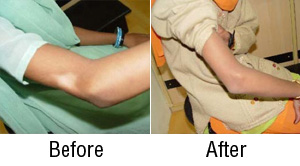The Most Common Types of Hand Problems:
If your hand is impaired in any way, surgery may improve your condition. This type of very specialized surgery can treat diseases that cause pain and impair the strength, function and flexibility of your wrist and fingers. Surgery seeks to restore to near normal the function of fingers and hands injured by trauma or to correct abnormalities that were present at birth. Specifically, hand surgery can treat

Ganglion Cysts:
Ganglion cysts are the most common mass or lump in the hand and are commonly found on the back of the wrist. These are generally non-cancerous, fluid-filled cysts and arise from irritation from the ligaments, joint linings, or tendon sheaths within the hand and wrist. Ganglion cysts are an inflammatory process and can change in size or disappear on their own.
Many ganglion cysts do not require treatment other than removing the repetitive irritation. However, if the cyst is chronically painful and interferes with your daily function our orthopaedic surgeon can recommend the different methods of intervention, to include surgical removal of the cyst. This may not permanently eliminate the cyst as they have been known to reoccur.
Carpal Tunnel Syndrome:
Carpal tunnel syndrome is characterized by numbness and tingling in the hand, especially at night or pain and numbness with prolonged gripping and/or upright positioning of the hand. In some cases the pain can go all the way up to the shoulder, or be caused by a nerve being pinched in the shoulder or elbow, this is why it is important to be correctly diagnosed by a trained physician.
The symptoms of carpal tunnel syndrome are caused by pressure on the median nerve as it passes through a tunnel in the wrist and into the hand. The tendons of your hand and thumb also travel in this tunnel, creating a small area for the structures to fit through.
Care for carpal tunnel syndrome can range from: rehabilitation, wearing a splint or brace to rest the wrist, steroid injections into the carpal canal to decrease swelling, and when non-surgical treatment is unsuccessful surgery may be required. Generally a combination of treatments are attempted prior to surgery as the outcomes of any procedure depend on how long the condition has existed and how much damage has been done to the nerve. For that reason, it's a good idea to see a doctor early if you think you may have carpal tunnel syndrome.
Arthritis of the Hand:
Rheumatoid arthritis is an inflammation of the joints that can become a progressive and disabling disease. It can affect any joint of the body, but in the hand it often deforms the finger joints and forces the fingers into an awkward position that hinders normal movements and causes pain.
Management of rheumatoid arthritis can often be managed without surgery by: wearing splints, physical therapy to strengthen weakened areas, anti-inflammatory medication, steroid injections into the joint, and other conservative methods. In some cases, surgeons can repair or reconstruct many areas of the fingers, hand, or wrist by removing tissue from inflamed joints, repositioning tendons, or implanting artificial joints. It is difficult to regain full function of the fingers, hand, and wrist but one can generally expect a significant improvement in function, pain, and  appearance. Like Cysts, removal or repair of the arthritic areas does not remove the cause of the disease and it can return, requiring additional treatments and surgeries. appearance. Like Cysts, removal or repair of the arthritic areas does not remove the cause of the disease and it can return, requiring additional treatments and surgeries.
Lateral Epicondylitis:
Lateral Epicondylitis is commonly known as “Tennis Elbow” and is a condition that develops when the tendons of the forearm pull from their attachment on the elbow; gradually pulling the tendons away from the bone. A majority of patients that develop this condition are over the age of 40 and generally do not play tennis.
Management of lateral epicondylitis “Tennis Elbow” can often be managed by: wearing splints, physical therapy to strengthen weakened areas, anti-inflammatory medication, steroid injections into the joint, and other conservative methods.
Hand Rehabilitation:
In most cases, therapy and specifically hand therapy, provided by a physical therapist, occupational therapist or a specialized certified hand therapist can enhance and in some cases speed your recovery to maximize the use of your fingers, hand, and wrist. Therapy is performed under the direction of your physician and the course of rehabilitation is carried out to accomplish many different goals of increasing range of motion, strength, function, and minimize scar tissue development and swelling. Your therapy may include hand exercises, heat and massage therapy, electrical nerve stimulation, splinting, traction, and special wrappings. Patients should know that surgery is one component of a full and successful recovery process, therapy is a second major factor, and following your physician’s orders in regards to modified activity, medications, and adhering to restrictions are the key factors is achieving your maximizing benefits.
|

